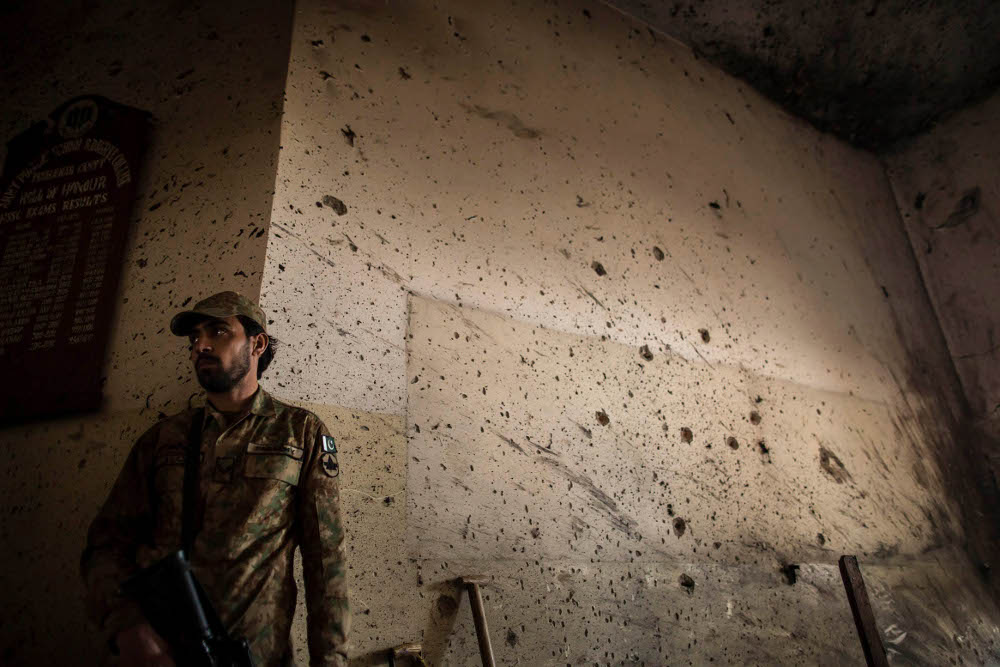Unresolved issues: A land audit could benefit the case for compensation.
For one of the world’s more parochial Islamist militant groups, the Pakistan Taliban, or Tehrik-e-Taliban Pakistan (TTP), has a habit of grabbing global headlines.
Set up in 2007 to unite a motley collection of local extremist outfits in the rough and restive regions along Pakistan’s frontier with Afghanistan, the movement has had much of its time and energy taken up with bitter internal competition and maintaining its ruthless rule over the enclaves it has carved out.
It has also battled Pakistani security forces and launched a series of increasingly audacious and lethal attacks beyond the frontier zones. Only once has it been linked to a global strike: a plan to bomb Times Square.
This latest operation — a bloody massacre at a school in Peshawar that left at least 141 dead, including 132 children — is a strike on all of these local fronts, with the added effect of assuring attention across the planet, though it is unlikely the latter was a priority.
The TTP has been under pressure in recent months. A series of internal splits has seen major factions peel off. The most important, made up of members of the powerful Mehsud tribe, has gone alone. Others have rejected the brutal violence that has long been a hallmark of the movement.
Breakaway group
Mohammed Khurasani, the spokesperson who claimed responsibility for the attack, has been in the job for only a few weeks. The previous incumbent left to join a breakaway group loyal to the Islamic State.
Security officials and experts know that when groups fragment and leadership is contested, attacks often become more extreme as individual commanders and their followers seek to prove themselves the most effective and the most audacious.
Violence, even directed at targets such as schools, also serves to reinforce disintegrating authority over communities in the enclaves where the militants are based. So too does the deployment of multiple suicide bombers — seven in this case.
The tactic, however common, remains an effective way of inspiring fear.
Since June, a new and very direct pressure has been applied to the TTP. The Pakistani military finally moved into the North Waziristan tribal agency, where dozens of groups threatening local, regional and international targets were based. The assault was seen as the climax to years of campaigning on the frontier, chasing militants out of successive strongholds.
Killed fighters
More than 1 000 fighters from the movement are thought to have been killed in the new push, as well as civilians.
The TTP, which has established a presence in most urban centres, launched a strike on the main international airport in Karachi, the southern port city that is the country’s commercial capital, shortly before the assault and more recently a huge bombing of a flag ceremony, claimed by a splinter group, on the western border with India. This latest attack is 32km short of the border. Is the TTP trying to show a capacity to strike across Pakistan?
Perhaps. Khurasani merely said that the operation was in revenge for children killed by the army offensive.

The Pakistan army has upped its offensive in North Waziristan, the base of militant groups. (Zohra Bensemra, Reuters)
Schools have long been in the crosshairs, however. More than 1 000 have been destroyed by Islamist militants from one faction or another in the province of Khyber Pakhtunkhwa in the past five years.
The institutions symbolise government authority and are seen as un-Islamic. This school is at the edge of a military “cantonment” in Peshawar, the capital of the province, and inevitably many pupils are the children of servicemen. It is a soft target, but one with powerful psychological impact.
Power struggle
The backdrop is Pakistan’s continuing power struggle between the army generals and the elected — if imperfect — civilian government. Nawaz Sharif, the prime minister, and Raheel Sharif, the army chief, flew to Peshawar. They did not travel together. Both said they wanted to oversee operations in person.
One of the many continuing concerns in Washington and elsewhere is Pakistan’s “selective” attitude towards Islamist militants.
Officials in Afghanistan and India have repeatedly accused Pakistan of harbouring militants responsible for a string of strikes in their countries. Special trains laid on last month for followers of Lashkar-e-Taiba, the Pakistan-based group behind the 2008 assault on Mumbai, enraged Delhi. The group is also blamed for an attack in Herat, western Afghanistan, earlier this year.
The Afghan Taliban leadership and other insurgent groups have long operated from Pakistan.
Pakistani officials rebut such claims and privately often blame their neighbours for the ongoing violence within Pakistan’s borders.
Delhi backing
The head of the TTP, Mullah Fazlullah, may be in northeastern Afghanistan, but some within the Pakistani security establishment remain convinced that Delhi is backing his campaigns. Both Narendra Modi, prime minister of India, and Ashraf Ghani, the new president of Afghanistan, condemned Tuesday’s attack.
But the toxic levels of mutual suspicion across the region, whatever the boilerplate expressions of solidarity today, make it hard to envisage any real improvement in relations between the three nations.
Few locally believe the United States withdrawal of combat troops from Afghanistan will help, with deep fears of a backwash of militants from the conflict seeking new targets.
Caught in the crossfire are helpless children. — © Guardian News & Media 2014